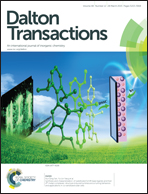Luminescent lanthanide MOFs based on conjugated 1,1′-ethynebenzene-3,3′,5,5′-tetracarboxylate ligand: syntheses, structures and photoluminescent properties†
Abstract
A family of novel lanthanide metal–organic frameworks (MOFs) with formula [Ln2(EBTC)1.5(CH3OH)4]·6H2O [EBTC4− = 1,1′-ethynebenzene-3,3′,5,5′-tetracarboxylate, Ln = La (1), Ce (2), Pr (3), Nd (4), Sm (5), Eu (6), Gd (7), Tb (8) and Dy (9)], have been synthesized via solvothermal reaction. All compounds are isostructural, crystallized in the monoclinic space group P21/n, and show a three-dimensional (4,6)-connected network with Schläfli symbol of {310}. Photoluminescent measurements indicated that 1 and 7 emit the luminescence originating from the intraligand π←π* transition, 2 shows the broadband emission due to allowed 4f–5d transitions, and 4–9 show the emission of typical lanthanide f–f transition via the ligand “antenna effect” in the solid state at ambient temperature. Interestingly, compounds 6 and 8 showed microsecond time-scale fluorescence lifetimes with 0.84 ms for 6 and 0.39 ms for 8, respectively. Such unique spectroscopy features may have applications in biomacromolecule research.


 Please wait while we load your content...
Please wait while we load your content...